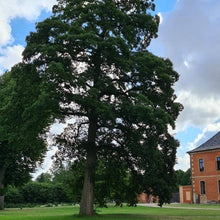The wood of the sessile oak is used in furniture construction and as construction timber. Native to Europe. Can also be used for single stands, afforestation and as a street tree. Hard and industry-proof, drought-resistant, road salt-proof, tolerates urban climates. The sessile oak is the tree of the year 2014.
Location
The sessile oak is undemanding, grows on clay soils, even on light, dry soils, and avoids high groundwater such as waterlogging
Characteristics
- Height: 40 m high
- Crown: high domed crown
- Trunk: diameter up to 100cm
- Root: pronounced taproot system
- Blossom / fruit: yellow-green blossom, May-June blossom, fruits in several acorns, short stalked, acorns enclosed by up to a quarter of the cup
- Leaves / needles
- Alternately 8-12 cm long, yellowish to brown in autumn, the leaves often stick to younger trees for a long time
For inquiries about origin, please use ourcontact form

Quercus petraea
Sessile oak
| 818 01 | Lower Saxony coastal area and Rhenish-Westphalian Bay |
| 818 02 | Baltic Sea coastal area |
| 818 03 | Heide and Altmark |
| 818 04 | East German lowlands |
| 818 05 | Central German low and hill country |
| 818 06 | Rhenish and Saarbergland |
| 818 07 | Harz, Weser and Hessian Mountains, except Spessart |
| 818 08 | Palatinate Forest |
| 818 09 | Upper Rhine Graben |
| 818 10 | Spessart |
| 818 11 | Franconian hill country |
| 818 12 | Southeast German Hill and Berland |
| 818 13 | South German low mountain range as well as Alps |






